|
|
|
Sort Order |
|
|
|
Items / Page
|
|
|
|
|
|
|
| Srl | Item |
| 1 |
ID:
151450


|
|
|
|
|
| Summary/Abstract |
This article examines some manuscripts of the so-called “Anonymous Histories of Shah Esmāʿil” with a view to answering the question: How did people in post-1514 Iran remember the Battle of Chālderān? After a brief examination of these manuscripts, the article focuses on three moments of the battle—the Safavid council of war, Esmāʿil’s clash with Malquch-oghli, and the Ottoman cannonade—to explore the ways in which popular memory embellished and altered the events we know from the official histories. Such changes reveal that the loss at Chālderān may have marked the end of Shah Esmāʿil’s aura of invincibility, but not of his larger-than-life image in the minds of his countrymen.
|
|
|
|
|
|
|
|
|
|
|
|
|
|
|
|
| 2 |
ID:
098432
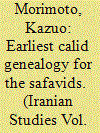

|
|
|
|
|
| Publication |
2010.
|
| Summary/Abstract |
Studies on the pre-dynastic claim of the Safavids to sayyid status suffer from a dearth of primary source materials. Scholars have advanced various conjectures, but it is not yet clear when the Safavids began to promote this claim or indeed when the so-called "official" Musavid genealogy was developed. This study presents a genealogical chart drawn in the third quarter of the fifteenth century (most probably in the 1460s) in Iraq (most likely in Najaf), which records the "official" genealogy in an unequivocal manner. This chart is a valuable document in that it testifies to the circulation of the "official" genealogy some three to four decades before the establishment of the Safavid dynasty. A survey of the studies to date on the question of the pre-dynastic claim is also offered in order to clarify the significance of the chart.
|
|
|
|
|
|
|
|
|
|
|
|
|
|
|
|
| 3 |
ID:
165775
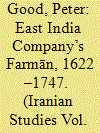

|
|
|
|
|
| Summary/Abstract |
The East India Company’s presence and ongoing trade in Persia was reliant on the privileges outlined in the Farmān, granted after the capture of Hormuz in 1622. The relationship between these two powers was cemented in the rights enshrined in the Farmān, which was used by both to regulate their varying needs and expectations over the course of 125 years. This article explores the Company’s records of the Farmān and how changes to its terms were viewed from both sides. As a Persian document, the Farmān gives a clear view of the attitudes of native officials and rulers to the Company and how these terms were used as a means of control.
|
|
|
|
|
|
|
|
|
|
|
|
|
|
|
|
| 4 |
ID:
178878
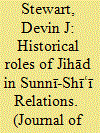

|
|
|
|
|
| Summary/Abstract |
This article provides a taxonomy of the ways in which jihād and jihād propaganda have been used in medieval Islamic history and in modern times within the framework of Sunnī-Shīʿī relations. It identifies five main relevant patterns of usage: I) Sunnī jihād against a Shīʿī foreign power; II) Shīʿī jihād against a Sunnī foreign power; III) Shīʿī use of jihād propaganda against a foreign power – usually a Christian power – as a means to gain legitimacy among Sunnīs; IV) Sunnī-Shīʿī cooperation and solidarity through jihād against a foreign power; and V) Sunnī jihād against an internal, Shīʿī enemy. It then discusses the implications of the continuity of these patterns over many centuries for the understanding of Sunnī-Shīʿī relations generally and critiques some aspects of recent scholarship on “sectarianization.”
|
|
|
|
|
|
|
|
|
|
|
|
|
|
|
|
| 5 |
ID:
154347
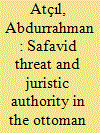

|
|
|
|
|
| Summary/Abstract |
This article investigates the opinions of three senior Ottoman jurists, Sarıgörez (d. 1522), Kemalpaşazade (d. 1534), and Ebussuud (d. 1574), on the subject of the Safavids and their supporters. Historians have treated these opinions as part of the vast polemical literature uniformly intended to justify an impending Ottoman attack against their Safavid rivals. Questioning the notion that all authors shared an undifferentiated attitude, this article underlines that, unlike most polemical literature, the opinions of these three jurists focused on the religiolegal aspects of the Safavid issue and varied and evolved in line with changing historical realities, the jurists’ divergent assessments of the Safavid threat, and their preference for different jurisprudential doctrines. Based on an analysis of the opinions, I argue that these jurists assumed a high degree of autonomy as producers and interpreters of the law and thus did not necessarily feel obliged to legitimate or excuse every imperial action.
|
|
|
|
|
|
|
|
|
|
|
|
|
|
|
|
| 6 |
ID:
168974
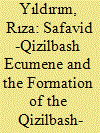

|
|
|
|
|
| Summary/Abstract |
Alevis, the largest religious minority of Turkey, also living in Europe and the Balkans, are distinguished from both Sunnis and Shiʿites by their latitudinarian attitude toward Islamic Law. Conceptualizing this feature as “heterodoxy,” earlier Turkish scholarship sought the roots of Alevi religiosity in Turkish traditions which traced back to Central Asia, on the one hand, and in medieval Anatolian Sufi orders such as the Yasawi, Bektashi, Qalandari, and Wafaʾi, on the other. A new line of scholarship has critiqued the earlier conceptualization of Alevis as “heterodox” as well as the assumption of Central Asian connections. In the meantime, the new scholarship too has focused on medieval Anatolian Sufi orders, especially the Bektashi and Wafaʾi, as the fountainhead of Alevi tradition. Critically engaging with both scholarships, this paper argues that it was the Safavid-Qizilbash movement in Anatolia, Azerbaijan, and Iran rather than medieval Sufi orders, that gave birth to Alevi religiosity.
|
|
|
|
|
|
|
|
|
|
|
|
|
|
|
|
|
|
|
|
|